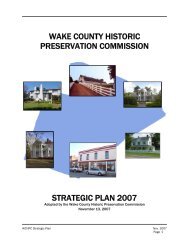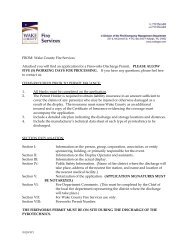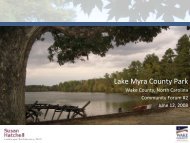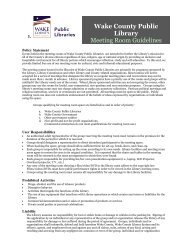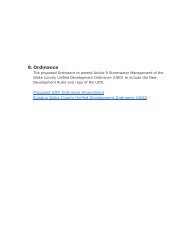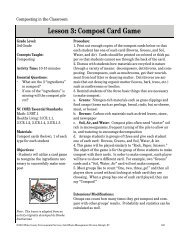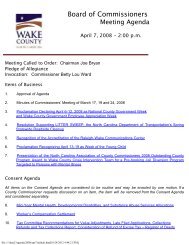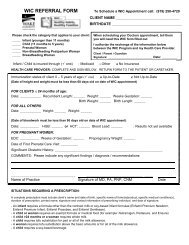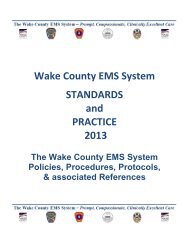Lesson 2: Deciphering Decomposers - Wake County Government
Lesson 2: Deciphering Decomposers - Wake County Government
Lesson 2: Deciphering Decomposers - Wake County Government
Create successful ePaper yourself
Turn your PDF publications into a flip-book with our unique Google optimized e-Paper software.
Composting in the Classroom<br />
<strong>Lesson</strong> 2: <strong>Deciphering</strong> <strong>Decomposers</strong><br />
Grade Level:<br />
6th Grade<br />
Concepts Taught:<br />
decomposition, observation, data<br />
collection, biodiversity<br />
Activity Time(s):<br />
2-3 class periods<br />
Essential Questions:<br />
What is a microorganism and<br />
what are the different types<br />
How does each type of microorganism<br />
help the decomposition<br />
process<br />
NC CORE/Essential Standards:<br />
Visual Arts 6.V.2.2, 6.V.2.3,<br />
Writing Standard 2, 4, 6, 8;<br />
Materials:<br />
Internet / online resources<br />
Decomposer matching sheets<br />
(included)<br />
Objectives:<br />
Students will explore and<br />
identify common microorganisms<br />
found in compost.<br />
Students will understand the<br />
roles that decomposers and<br />
detritivores play in compost.<br />
Procedure:<br />
1. Provide students with template sheets that list the names of<br />
the following decomposer / detritivore microorganisms commonly<br />
found in compost: actinomycetes, bacillus, saprophytes,<br />
protozoa, rotifer, and nematode.<br />
2. Students should choose or be assigned one of the microorganism<br />
names.<br />
3. Without using any prior knowledge or images students should<br />
use imagination and creativity, then develop a written and<br />
artistic description for the chosen microorganism. Written<br />
descriptions should include what role they think the microorganism<br />
plays in the compost pile.<br />
4. Then using the Internet and/or online encyclopedias, have students<br />
find factual information about the chosen microorganism<br />
and prepare a brief report. Students should include a<br />
picture or sketch of what the microorganism actually looks<br />
like.<br />
Extensions:<br />
Have students prepare a display or presentation based on their<br />
creative written and artistic compost microorganism description<br />
OR their brief factual report.<br />
Have students write a skit, based on the roles that each microorganism<br />
plays in the compost pile.<br />
As a follow-up activity: cut apart the pictures, names, and descriptions<br />
of compost microorganisms printed on the following<br />
pages. Then have students match each name and description to<br />
the correct picture.<br />
Note: *(<strong>Decomposers</strong>, such as mushrooms,<br />
get their nourishment from leaf<br />
litter or decaying matter. Detritivores<br />
are animals that eat decaying organic<br />
matter (leaves, bark, trees, etc.) such as<br />
earthworms or beetles.)<br />
©2010 <strong>Wake</strong> <strong>County</strong> Environmental Services, Solid Waste Management Division, Raleigh, NC 111
Composting in the Classroom<br />
Name _______________________________________<br />
Name of organism:________________________________________________________<br />
Description of organism (including its role in the compost pile):<br />
©2010 <strong>Wake</strong> <strong>County</strong> Environmental Services, Solid Waste Management Division, Raleigh, NC 112
Composting in the Classroom<br />
www.antibiotics.riken.go.jp/.../nocardia.jpg<br />
ACTINOMYCETES<br />
Bacteria that grow in multicellular filaments similar<br />
to fungi. They contain enzymes that break down<br />
tough woody materials in the compost pile.<br />
©2010 <strong>Wake</strong> <strong>County</strong> Environmental Services, Solid Waste Management Division, Raleigh, NC 113
Composting in the Classroom<br />
www-micro.msb.le.ac.uk/video/graphics/Bcereus.jpg<br />
BACILLUS<br />
Rod-shaped bacteria that use enzymes to break<br />
down organic matter. They reproduce in high numbers<br />
as the compost pile’s temperature begins to<br />
rise.<br />
©2010 <strong>Wake</strong> <strong>County</strong> Environmental Services, Solid Waste Management Division, Raleigh, NC 114
Composting in the Classroom<br />
http://www.niaes.affrc.go.jp/inventry/microorg/eng/z59e-Arth-st.html<br />
SAPROPHYTES<br />
Fungi that grow and spread quickly throughout<br />
the outer layers of the compost pile. They digest<br />
organic material that bacteria cannot break down.<br />
©2010 <strong>Wake</strong> <strong>County</strong> Environmental Services, Solid Waste Management Division, Raleigh, NC 115
Composting in the Classroom<br />
http://soils.tfrec.wsu.edu/mg/flagella.jpg<br />
PROTOZOA<br />
Microscopic unicellular organisms that feed on<br />
organic matter and bacteria and fungi in the<br />
compost pile.<br />
©2010 <strong>Wake</strong> <strong>County</strong> Environmental Services, Solid Waste Management Division, Raleigh, NC 116
Composting in the Classroom<br />
http://www.ycy63.dial.pipex.com/freshwater/rotifer.html<br />
ROTIFER<br />
Microscopic multicellular organism found in water<br />
droplets throughout the compost pile. These<br />
organisms feed on organic matter and bacteria<br />
and fungi in the compost.<br />
©2010 <strong>Wake</strong> <strong>County</strong> Environmental Services, Solid Waste Management Division, Raleigh, NC 117
Composting in the Classroom<br />
http://plantpath.caes.uga.edu/extension/nematodes/ring.html<br />
NEMATODE<br />
Microscopic, cylinder-shaped worm that<br />
feeds on decaying matter, bacteria, fungi,<br />
and protozoa in the compost pile.<br />
©2010 <strong>Wake</strong> <strong>County</strong> Environmental Services, Solid Waste Management Division, Raleigh, NC 118
Composting in the Classroom<br />
<strong>Deciphering</strong> <strong>Decomposers</strong> Grading Rubric<br />
CATEGORY 4 3 2 1<br />
Written Description<br />
-<br />
Imaginative &<br />
Creative<br />
The physical description<br />
is adequate and the role of<br />
the microorganism is addressed.<br />
The physical description<br />
is adequate but the role of<br />
the microorganism is not<br />
addressed.<br />
The physical description<br />
is not adequate but the<br />
role of the microorganism<br />
is addressed.<br />
The physical description<br />
is not adequate and<br />
the role of the organism<br />
is not addressed.<br />
Illustration -<br />
Imaginative &<br />
Creative<br />
The illustration matches<br />
the physical description<br />
given in the written portion<br />
and features many<br />
creative elements of design.<br />
The illustration matches<br />
the physical description<br />
given in the written portion<br />
and features some<br />
creative elements of design.<br />
The illustration matches<br />
the physical description<br />
given in the written portion<br />
but does not attempt<br />
to be creative in design.<br />
The illustration does not<br />
match the physical description<br />
given in the<br />
written portion.<br />
Written - Factual<br />
Information clearly relates<br />
to the assigned microorganism.<br />
The report includes<br />
several supporting<br />
details and/or examples.<br />
Information clearly relates<br />
to the assigned microorganism.<br />
The report includes<br />
1-2 supporting<br />
details and/or examples.<br />
Information clearly relates<br />
to the assigned microorganism.<br />
No details and/or<br />
examples are given.<br />
Information has little or<br />
nothing to do with the<br />
assigned microorganism.<br />
Illustration -<br />
Factual<br />
The illustration is accurate<br />
and adds to the understanding<br />
of the topic.<br />
The illustration is accurate<br />
but does not add to the<br />
understanding of the<br />
topic.<br />
The illustration is inaccurate.<br />
No illustration is included.<br />
Overall Achievement<br />
All products completed<br />
and products indicate understanding<br />
of the topic.<br />
Some products completed<br />
and products indicate understanding<br />
of the topic.<br />
Some products completed,<br />
but products do not indicate<br />
understanding of the<br />
topic.<br />
No products completed.<br />
©2010 <strong>Wake</strong> <strong>County</strong> Environmental Services, Solid Waste Management Division, Raleigh, NC 119
Composting in the Classroom<br />
http://www2.una.edu/microaquarium/images/Nematodes/nema03cm.jpg<br />
NEMATODE<br />
Microscopic, cylinder-shaped worm that feeds on<br />
decaying matter, bacteria, fungi, and protozoa in<br />
the compost pile.<br />
©2010 <strong>Wake</strong> <strong>County</strong> Environmental Services, Solid Waste Management Division, Raleigh, NC 120



